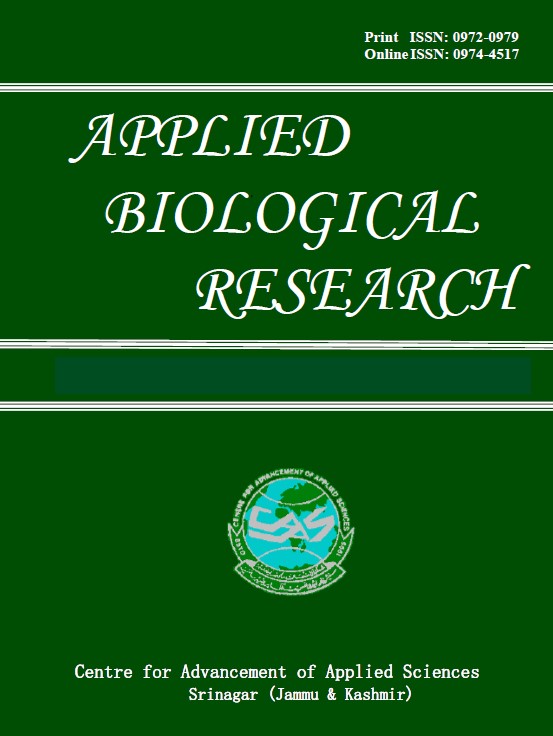CHARACTERIZATION OF ETHYL ACETATE-BASED LEAF EXTRACT OF Entada rheedii Spreng. BY USING LIQUID CHROMATOGRAPHY QUADRUPOLE TIME-OF-FLIGHT MASS SPECTROMETRY
DOI:
https://doi.org/10.48165/abr.2025.27.01.27Keywords:
Entada rheedii, ethyl acetate extract, plant secondary metabolites, characterization, bioactivity analysisAbstract
Plants possess diverse characteristics and medicinal properties, and since antiquity, various parts such as leaves, stems, roots, rhizomes, flowers, tendrils, and bulbs have been utilized in the preparation of therapeutic products. Entada rheedii Spreng., a species native to tropical regions, has traditionally been used to treat a range of ailments. The present study aimed to characterize the major chemical constituents of E. rheedii leaf extract using liquid chromatography coupled with quadrupole-time-of-flight mass spectrometry (LC-MS-QTOF). This analytical technique facilitated the identification of several bioactive flavonoids, including apigenin, genistein, kaempferol, nicoflorin, astragalin, quercetin, and spiraeoside. LC-MS-QTOF analysis revealed distinct peaks corresponding to these compounds, with retention times of 4.79 and 8.58 minutes. Structural confirmation was achieved through consistent fragmentation patterns. These flavonoids are known for their significant pharmacological activities, including antioxidant, anti-inflammatory, and anticancer effects. The findings provide valuable insights into the phytochemical profile of E. rheedii leaves, supporting their potential medicinal applications.
Downloads
References
Ali, A., Bashmil, Y.M., Cottrell, J.J., Suleria, H.A.R., & Dunshea, F.R. (2021). LC-MS/MS-QTOF screening and identification of phenolic compounds from Australian grown herbs and their antioxidant potential. Antioxidants (Basel), 10(11), 1770. https://doi.org/10.3390/antiox10111770
Allen, D.R., & McWhinney, B.C. (2019). Quadrupole time-of-flight mass spectrometry: A paradigm shift in toxicology screening applications. Clinical Biochemistry Reviews, 40, 135–146.
Allemailem, K.S., Almatroudi, A., Alharbi, H.O.A., Al-Suhaymi, N., Alsugoor, M.H., Aldakheel, F.M., et al. (2024). Apigenin: A bioflavonoid with a promising role in disease prevention and treatment. Biomedicines, 12, 1353. https://doi.org/10.3390/biomedicines12061353
Colby, J.M., & Lynch, K.L. (2018). Drug screening using liquid chromatography quadrupole time-of-flight (LC-QqTOF) mass spectrometry. In D.R. Dekant (Ed.), Methods in Molecular Biology (pp. 181–190). Humana Press.
El Sayed, A.M., Basam, S.M., El-Naggar, E.B.A., Marzouk, H.S., & El-Hawary, S. (2020). LC-MS/MS and GC-MS profiling as well as the antimicrobial effect of leaves of selected Yucca species introduced to Egypt. Scientific Reports, 10, 17778. https://doi.org/10.1038/s41598-020-74911-3
Gupta, R., Sharma, A., & Kumar, V. (2023). Comprehensive phytochemical profiling of herbal extracts using LC-MS/MS. Phytochemical Analysis, 34, 45–52.
Kopustinskiene, D.M., Kornysova, O.V., & Lazutka, J.R. (2020). Flavonoids as anticancer agents: A review. Molecules, 25, 1234. https://doi.org/10.3390/molecules25051234
Long, T., Gu, R., Linghu, C., Long, J., Kennelly, E.J., & Long, C. (2023). UPLC-QTOF-MS-based metabolomics and chemometrics studies of geographically diverse Acer truncatum leaves: A traditional herbal tea in Northern China. Food Chemistry, 417, 135873. https://pubmed.ncbi.nlm.nih.gov/36933422/
Nair, L.R., & Balasubrahmanian, M. (2023). Correlation between phytochemicals and antioxidant activities of different leaf extracts of Entada rheedii. Journal of Plant Science Research, 39, 199–208.
National Center for Biotechnology Information. (2025). PubChem Compound Summary for CID 5280443, Apigenin. Retrieved July 25, 2025, from https://pubchem.ncbi.nlm.nih.gov/compound/Apigenin
National Center for Biotechnology Information. (2024). PubChem Compound Summary for CID 5282102, Astragalin. Retrieved October 6, 2024, from https://pubchem.ncbi.nlm.nih.gov/compound/Astragalin
National Center for Biotechnology Information. (2024). PubChem Compound Summary for CID 5490064, Avicularin. Retrieved October 13, 2024, from https://pubchem.ncbi.nlm.nih.gov/compound/Avicularin
National Center for Biotechnology Information. (2024). PubChem Compound Summary for CID 5280961, Genistein. Retrieved October 6, 2024, from https://pubchem.ncbi.nlm.nih.gov/compound/Genistein
National Center for Biotechnology Information. (2025). PubChem Compound Summary for CID 5318717, Juglanin. Retrieved July 25, 2025, from https://pubchem.ncbi.nlm.nih.gov/compound/Juglanin
National Center for Biotechnology Information. (2024). PubChem Compound Summary for CID 5318767, Kaempferol-3-O-rutinoside. Retrieved October 13, 2024, from https://pubchem.ncbi.nlm.nih.gov/compound/Kaempferol-3-O-rutinoside
National Center for Biotechnology Information. (2024). PubChem Compound Summary for CID 100332, Loliolide. Retrieved October 11, 2024, from https://pubchem.ncbi.nlm.nih.gov/compound/Loliolide
National Center for Biotechnology Information. (2025). PubChem Compound Summary for CID 5280343, Quercetin. Retrieved June 7, 2025, from https://pubchem.ncbi.nlm.nih.gov/compound/Quercetin
National Center for Biotechnology Information. (2024). PubChem Compound Summary for CID 5320844, Spiraeoside. Retrieved October 6, 2024, from https://pubchem.ncbi.nlm.nih.gov/compound/Spiraeoside
Nile, S.H., Nile, A., & Kim, D.H. (2021). Spiraeoside: A comprehensive review on its phytochemistry, pharmacology, and potential applications. Food and Chemical Toxicology, 154, 112345. https://pubmed.ncbi.nlm.nih.gov/34116102/
Nzowa, L.K., Barboni, L., Teponno, R.B., Ricciutelli, M., Lupidi, G., Quassinti, L., et al. (2010). Rheediinosides A and B, two antiproliferative and antioxidant triterpene saponins from Entada rheedii. Phytochemistry, 71, 254–261.
Rather, R.A., & Bhagat, M. (2019). Quercetin: A comprehensive review on its anticancer potential. Anti-Cancer Agents in Medicinal Chemistry, 19, 145–156.
Riaz, A., Rasul, A., Hussain, G., Zahoor, M.K., Jabeen, F., Subhani, Z., et al. (2018). Astragalin: A bioactive phytochemical with potential therapeutic activities. Advances in Pharmacological and Pharmaceutical Sciences, 2018(1), 9794625. https://doi.org/10.1155/2018/9794625
Rutkowska, M., Witek, M., & Olszewska, M.A. (2024). A comprehensive review of molecular mechanisms, pharmacokinetics, toxicology and plant sources of juglanin: Current landscape and future perspectives. International Journal of Molecular Sciences, 25(19), 10323. https://doi.org/10.3390/ijms251910323
Salim, K.S., Harun, A., Aziz, N.A., Daud, S., & So’ad, S.Z.M. (2024). Bioactive phytochemicals and pharmacological facets of Entada species in Asia: A review. Malaysian Journal of Analytical Sciences, 28, 1210–1230.
Shafaat-Al-Mehedi, M., Hasan, C.M., & Haque, M.R. (2015). Isolation of flavonoids from the bark of Entada rheedii Spreng. Oriental Pharmacy and Experimental Medicine, 15, 347–351.
Sharmila, A., & Selvaraj, C.I. (2024). LC–MS/MS-QTOF analysis of Anodendron parviflorum (Roxb.) leaves extract and exploring its antioxidant, antimicrobial, and cytotoxic potential. Future Journal of Pharmaceutical Sciences, 10, 122. https://doi.org/10.1186/s43094-024-00695-1
Sugimoto, S., Matsunami, K., & Otsuka, H. (2018). Biological activity of Entada phaseoloides and Entada rheedii. Journal of Natural Medicines, 72, 12–19.
Tapondjou, L.A., Kamanzi Atchou, G., Gatsing, D., & Tane, P. (2002). Antimicrobial and cytotoxic properties of some medicinal plants from Cameroon. Fitoterapia, 73, 51–56.
Tian, C., Liu, X., Chang, Y., Wang, R., Lv, T., Cui, C., & Liu, M. (2021). Investigation of the anti-inflammatory and antioxidant activities of luteolin, kaempferol, apigenin and quercetin. South African Journal of Botany, 137, 257–264. https://doi.org/10.1016/j.sajb.2020.10.022
Tuli, H.S., Sharma, A.K., & Kashyap, D. (2019). Genistein: A comprehensive review of its molecular mechanisms and therapeutic potential in cancer. Frontiers in Pharmacology, 10, 1047. https://doi.org/10.3389/fphar.2019.01336
Usman, M., Khan, W.R., Yousaf, N., Akram, S., Murtaza, G., Kudus, K.A., et al. (2022). Exploring the phytochemicals and anti-cancer potential of the members of Fabaceae family: A comprehensive review. Molecules, 27, 3863. https://doi.org/10.3390/molecules27123863

